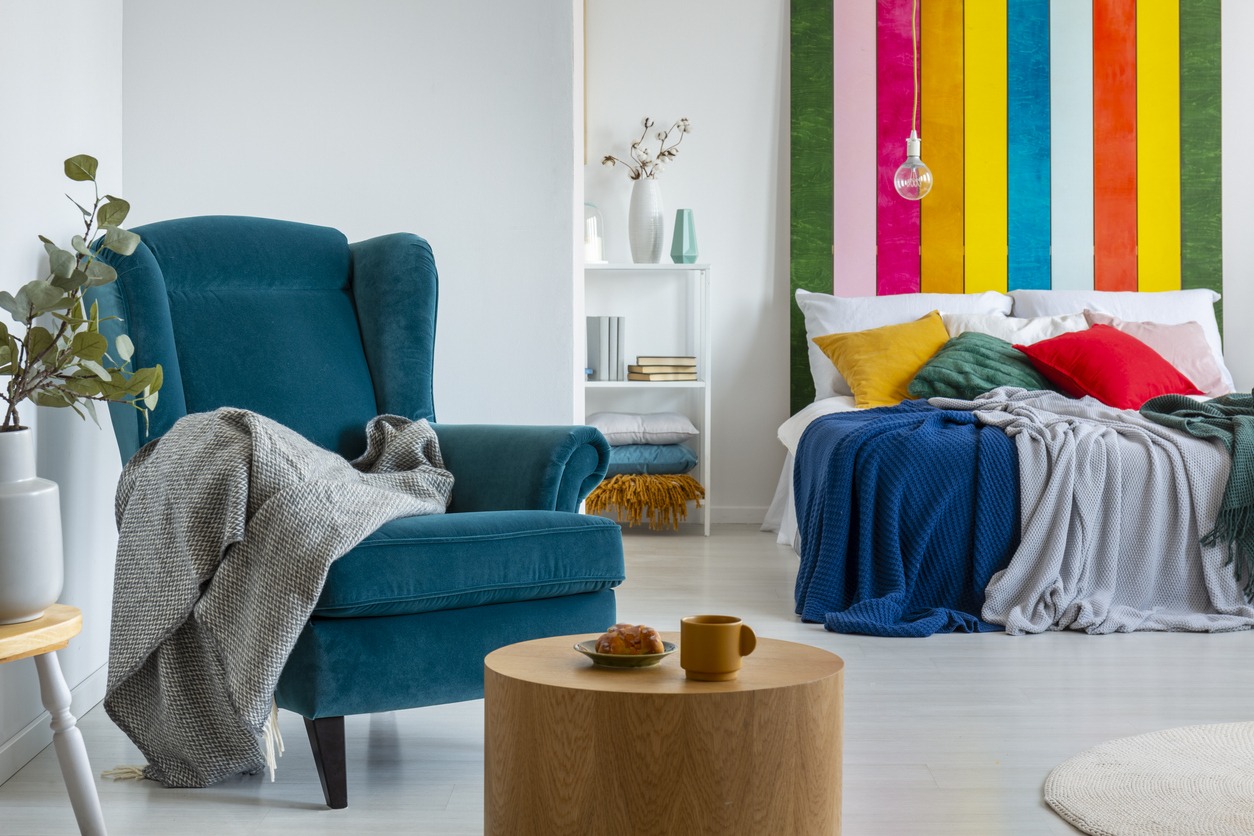A focal point in interior design is the central element that draws attention and sets the tone for the room. It can be a furniture piece, artwork, or an architectural feature.
Using paint to create focal points is crucial because it helps highlight specific areas, adds depth, and enhances the space’s overall aesthetic. By strategically using color and contrast, paint can direct the eye, emphasize key design elements, and create a more visually engaging environment.
Understanding focal points
Focal point in interior design
A focal point is a crucial feature or area in a room that draws immediate attention and serves as the center of visual interest. It could be anything from a fireplace, a large piece of artwork, a striking piece of furniture, or even a window with a stunning view.
Impact on room aesthetics and ambiance
Focal points are crucial in shaping a room’s aesthetics and ambiance. They anchor the space, providing a sense of balance and direction for the eye. A well-chosen focal point enhances the overall design by adding depth and character, helping to create a cohesive look. It can also set the tone for the room’s atmosphere, whether warm and inviting, bold and dramatic, or calm and serene. Without a clear focal point, a room may feel disjointed or lack a defined sense of style.
Choosing the right wall
When selecting the ideal wall for creating a focal point in a room, consider the following tips:
1. Choosing the right wall
- Natural focal points: Often, the wall facing the main entrance, behind a significant piece of furniture like a bed or sofa, or around a fireplace or large window makes an excellent focal point.
- Unobstructed views: Choose a wall unobstructed by doors, large windows, or heavy furniture to allow the focal point to stand out.
2. Room size considerations
- Small rooms: Use a focal point to create a sense of depth. A bold color or striking art on one wall can make the room feel larger.
- Large rooms: Consider breaking up the space with multiple focal points to avoid overwhelming the room.
3. Layout considerations
- Symmetry: Align the focal point with other crucial elements in the room, like a rug or light fixture, to create balance.
- Asymmetry: For a more dynamic look, choose an off-center wall and complement it with varied decor on the other walls.
4. Existing decor
- Color palette: Ensure the focal point wall complements the room’s color scheme but is distinct enough to draw attention.
- Texture and patterns: Incorporate texture (e.g., wallpaper, wood paneling) or patterns to add interest without clashing with existing decor.
- Artwork and accessories: Use artwork, mirrors, or shelves that reflect the room’s style to enhance the focal point without overwhelming it.
Selecting the perfect color

Selecting the perfect color for a room involves a mix of personal preference, the room’s purpose, and its existing elements. Here’s a brief guide:
Choosing colors that stand out and complement
- Consider the room’s function: Start by thinking about how you use the room. Calming colors like soft blues or greens work well in bedrooms, while vibrant colors like yellows or oranges can energize kitchens and living spaces.
- Evaluate existing elements: Look at the furniture, flooring, and décor already in the room. Go for a color that complements these elements by matching their tones or providing a subtle contrast.
- Lighting matters: Natural and artificial lighting can change how a color looks. Test paint samples in different lighting conditions to see how they appear throughout the day.
Using bold, contrasting, and Accent colors
- Bold colors: If you want a color that stands out, consider using bold hues like deep blues, rich reds, or emerald greens. These can create a dramatic effect, especially on an accent wall.
- Contrasting colors: To create contrast, use colors opposite each other on the color wheel (e.g., blue and orange, purple and yellow). It adds visual interest and can make certain elements pop.
- Accent colors: Incorporate accent colors through minor elements like trim, furniture, or accessories. Doing so allows you to experiment with bolder shades without overwhelming the room.
Remember, balance is key. Mixing bold and subtle tones can help you achieve a cohesive yet dynamic look.
Painting techniques and patterns
1. Stripes
Stripes can add height or width to a room and create a dynamic visual effect.
Step-by-step instructions:
- Prep the room: Clean the walls and apply a base coat of paint (usually a lighter color).
- Measure and mark: Decide on the width of your stripes. Use a tape measure to mark the stripes on the wall.
- Apply painter’s tape: Apply tape along the outside of your marks, pressing down firmly to prevent paint bleeding.
- Paint the stripes: Paint within the taped sections using a roller or brush.
- Remove tape: Remove the tape before the paint fully dries to avoid peeling.
2. Geometric Patterns
Geometric patterns like chevrons, triangles, or diamonds add modern and sophisticated detail.
Step-by-step instructions:
- Prep the room: Clean walls and apply a base coat if desired.
- Plan your design: Sketch out the pattern on paper, then use a ruler and level to draw it on the wall lightly.
- Tape the design: Apply painter’s tape along the lines, pressing firmly to prevent bleeding.
- Paint the shapes: Use a brush or roller to fill in the shapes, alternating colors as needed.
- Remove tape: Carefully remove the tape before the paint fully dries.
3. Ombre effect
The ombre technique creates a gradient of color that adds depth and a soothing visual flow.
Step-by-step instructions:
- Prep the room: Clean the walls and apply the lightest shade of paint as the base coat.
- Divide the wall: Mark the wall into sections where the color transitions will occur.
- Mix paint: Prepare the middle and darkest shades by mixing the base color with darker hues.
- Blend the colors: Starting at the top, paint the darkest color and blend downward into the next section. Use a dry brush or sponge to blend the edges where the colors meet.
- Final touches: Allow the wall to dry and touch up areas where the blend isn’t smooth.
These techniques offer creative ways to personalize a space and add character through paint.
Enhancing focal points with decor

Enhancing focal points in a room can dramatically elevate the space. Here’s how to do it:
Accessorizing the focal wall
- Artwork: Large-scale art pieces or a gallery wall can draw attention. Choose art that complements the room’s color scheme and style.
- Shelves: Floating shelves allow for versatility. Style them with a mix of books, plants, and small sculptures to add dimension.
- Furniture: Place a statement piece, like a bold-colored sofa or a unique console table, against the focal wall. This grounds the space and provides a functional element.
Balancing the focal point
- Complementary accents: Ensure that other elements in the room don’t compete with the focal point. Use subtler colors and simpler designs elsewhere.
- Symmetry and scale: Balance the focal point with furnishings on either side or opposite it. For example, if the focal wall features bold art, balance it with more basic décor on the opposite wall.
- Lighting: Use lighting to enhance the focal point without overwhelming it. Accent lights or sconces can highlight the area effectively.
Conclusion
You can use paint to emphasize specific areas, create depth, and improve the overall visual appeal of your home. Strategically employing color and contrast in paint can guide the viewer’s gaze, highlight essential design features, and establish a more visually captivating setting.
Feel free to experiment with your designs and make your space truly unique. We’d love to see how your projects turn out, so don’t hesitate to share your results with us! If you’re looking for professional assistance or have any questions, contact Custom Painting, Inc. today—we’re here to help bring your vision to life. For a free estimate request, call us at 925-294-8062 or use our contact form to message us.

